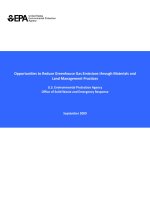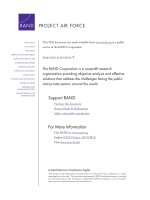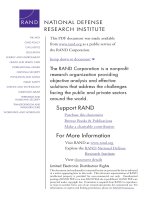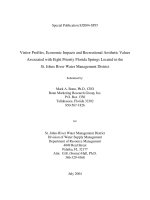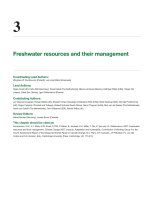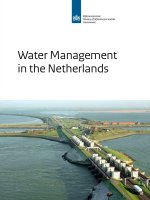water resources and water management
Bạn đang xem bản rút gọn của tài liệu. Xem và tải ngay bản đầy đủ của tài liệu tại đây (18.85 MB, 399 trang )
WATER RESOURCES
AND
WATER MANACEMENT
DEVELOPMENTS IN WATER SCIENCE,
28
OTHER TITLES IN THW SERIES
1
COMPUTER SYSTEMS AND WATER RESOURCES
2
H.L. GOLTERMAN
PHYSIOLOGICAL LIMNOLOGY
3
MULTIOBJECTIVE OPTIMIZATION IN WATER RESOURCES SYSTEMS:
THE SURROGATE WORTH TRADE-OFFMETHOD
4
J.J. FRIED
GROUNDWATER POLLUTION
G. BUGLIARELLO AND F. GUNTER
Y.Y. HAIMES, W.A. HALL AND H.T. FREEDMAN
5
N.
RAJARATNAM
TURBULENT JETS
6
D. STEPHENSON
PIPELINE DESIGN FOR WATER ENGINEERS
GROUNDWATER HYDRAULICS
8
J.BALEK
HYDROLOGY AND WATER RESOURCES IN TROPICAL AFRICA
9
T.A.McMAHONANDR.G.MElN
RESERVOIR CAPACITY AND YIELD
10
G.KOVAC5
SEEPAGE HYDRAULICS
7
v.
HALEK
AND
J.
SVEC
11
HYDRODYNAMICS OF LAKES: PROCEEDINGS OF A SYMPOSIUN
W.H. GRAF AND C.H. MORTIMER (EDITORS)
12-13 OCTOBER 1978, LAUSANNE, SWITZERLAND
12
CONTEMPORARY HYDROGEOLOGY: THE GEORGE BURKE MAXEY MEMORIAL VOLUME
SEEPAGE AND GROUNDWATER
14
D.
STEPHENSON
STORMWATER HYDROLOGY AND DRAINAGE
15
D.
STEPHENSON
PIPELINE DESIGN FOR WATER ENGINEERS
(completely revised edition
of
Vol.
6 in the series)
SYMPOSIUM ON GEOCHEMISTRY OF GROUNDWATER
17
TIME SERIESMETHODS IN HYDROSCIENCES
W.
BACK AND D.A. STEPHENSON (EDITORS)
13
M.A.
MARI~~O
AND
J.N.
LUTHIN
16
w.
BACK
AND
R.
L~TOLLE
(EDITORS)
A.H. ELSHAARAWI (EDITOR) IN COLLABORATION WITH
S.R.
ESTERBY
18
J.BALEK
HYDROLOGY AND WATER RESOURCES IN TROPICAL REGIONS
19
D.
STEPHENSON
PIPEFLOW ANALYSIS
20
I.
ZAVOIANU
MORPHOMETRY OF DRAINAGE BASINS
21
M.M.A. SHAHIN
HYDROLOGY OF THE NILE BASIN
22
H.C.RlGGS
STREAMFLOW CHARACTERISTICS
23
M. NEGULESCU
MUNICIPAL WASTEWATER TREATMENT
24
L.G. EVERETT
GROUNDWATER MONITORING HANDBOOK
FOR
COAL AND OIL SHALE DEVELOPMENT
25
W. KINZELBACH
GROUNDWATER MODELLING: AN INTRODUCTION WITH SAMPLE PROGRAMS IN BASIC
26
KINEMATIC HYDROLOGY AND MODELLING
27
WORKSHOP HELD AT THE CANADIAN CENTRE FOR INLAND WATERS, OCTOBER 1985
D.
STEPHENSON AND
M.E.
MEADOWS
A.M. EL
SHAARAWI
AND
R.E.
KWIATKOWSKI
(EDITORS)
STATISTICAL ASPECTS
OF
WATER QUALITY MONITORING
-
PROCEEDINGS OF THE
WATER
RESOURCES AND
WATER
MANAGEMENT
MILAN
K.
JERMAR
Becker Gundhalstr.,
18,0-8000
Munchen
71,
F.R.G.
E
LSEVl
E R
Amsterdam
-
Oxford
-
New
York
-
Tokyo
1987
ELSEVIER SCIENCE PUBLISHERS B.V.
Sara Burgerhartstraat
25
P.O. Box
21
1,
1000 AE Amsterdam, The Netherlands
Distributors
for
the United States and Canada:
ELSEVIER SCIENCE PUBLISHING COMPANY INC.
52,
Vanderbilt Avenue
New York, N.Y. 10017, USA.
Lihrsrv
Id
C(r*i!gress
Cataloginl-in-Publicofion
Data
Jermar, Milan
K.
Water r~sources and water management.
(Developments
in
water science
;
28)
Bibliography: p.
Includes index.
1.
Water-supply.
2.
Hydrologic cycle.
1.
Title.
-
11.
Series.
TD345.Jh7
1987
553.7
86-24114
ISBN
0-444-42717-1
(U.S.)
ISBN
0-444-42717-1
(Val.
28)
ISBN 0-444-41669-2 (Series)
0
Elsevier Science Publishers B.V., 1987
All rights reserved. No part of this publication may be reproduced, stored in a retrieval system or
transmitted in any form or by any means, electronic, mechanical, photocopying, recording or other-
wise, without the prior written permission of the publisher, Elsevier Science Publishers B.V./Science
&
Technology Division, P.O.
Box
330,
1000
AH Amsterdam, The Netherlands.
Special regulations for readers in the
USA
-
This publication has been registered with the Copyright
Clearance Center
fnc.
ICCC), Salem, Massachusetts. Information can be obtained from the CCC about
conditons under which photocopies of parts of this publication may be made in the USA. All other
copyright questions, including photocopying outside of the USA, should be referred to the publisher.
Printed in The Netherlands
CONTEm
Chapter
1
1.1
1.2
1.3
1.4
1.5
1.6
1.7
I
.8
WATER
OCCURRENCE
AND
ITS
FUNCTION
IN
NATIJRAL
SYSTENS
SYSTEMS
OF
THE
NATITRAT,
ENVIRONMENT
ENERGY
INPUT
AS
A
CALJSE
OF
THE
HYDROIBGIC
CYCLE
HYDROLOGIC CYCTX SYSTEM
1.3.1 Evaporation
1.3.2
Precipitation
1.3.3
Interception
1.3.4
1.3.5
Infiltration
1.3.6
Subsurface
Water
Movement
1.3.7
Flow in Channel Network
Depression and Detention Storage; Overland Flow
INTERREMITION OF SURFACE
AND
GROUNDWATER
RUNOFF
GROUNDWATER
LEVEL REGTJTATION, SOIL kDISTURE
AND
SOIL
STRUCTURE FORMATION
CLIMATOLOGICAL FUNCTIONS OF
WATER
AICGEOCHENICATJ
CYCLE
SYSTEM
1.7.1
Water
Erosion as
a
Process Evoked
by
the
Water
Cycle
Water
Quality as
a
Product
of
its
Circulation
1.7.2
HYDROLOGIC
CYCLE
AS
REGULATOR
OF B1OZI)GICAL PROCESSES
1.8.1
Interrelationships of Aquatic Ecosystems and
Water Quality
V
Page
1
3
8
10
18
21
22
23
25
32
33
40
45
50
55
60
71
77
83
1.9
RUNOFF PROCESS
AS
REGITLATOR
OF
THE
LIVING
ENVIRONMENT
VI
Chapter
2
WATE3
AND
ITS
FLWCTION
IN
SOCIA;,
SYSTENS
2.1
CATEGORIES
OF
WATER
mILIZATION
2.2
2.3
IN-STRmY
AND
ON-SITE
WATER
USE
WATER
REQUIREYEFTS
AND
WATER
CONSUMPTION
2.3.1
Waste Disposal
2.3.2
Inland \.!a ter Transport
2.3.3
Water Power Utilization
2.3.4
Water for Recreation
86
88
93
94
103
111
115
2.4
XDICIPAL
AND
RURAL
WATER REQUIREMENTS
120
2.4.1
Nater Requirements for Drinking and
Cooking
Purposes
121
2.4.2
Water Requirements for Other Domestic
Uses
130
2.4.3
Urban Public Water Requirements
134
2.4.4
Management
of
Water Delivery and Disposal
139
2.5
INDTJSTRIAL
WATER
SUPPLY
AND
RE-USE
SYSTEMS
144
2.5.1
Water for Processing, Nining and Hydraulic
Transport
153
2.5.2
Cooling Water
155
2.5.3
Boiling and Steam Power
Water
157
2.5.4
Water
Losses
in Industry and
Flm
Chart of
Water
Use
160
2.5.5
Waste [.la
ters
and
Was
te-free Technologies
165
2.6
WATER
IN
AGRICILTUWL
SYSTEE
169
2.6.1
Agricultural Production and Agricultural Yield
I72
2.6.2
Efficiency of Irrigation Water
IJse
181
2.6.3
Water
for
Irrigation and
its
Quality
185
Chapter
3
3.1
3.2
3.3
3.4
3.5
3.6
3.7
3.8
3.9
3.10
3.11
Chapter
4
4.1
4.2
4.3
2.6.4
Irrigation as Supplementary Watering
2.6.5
Fertilizing and Remedial Irrigation
2.6.6
Protective Irrigation
2.6.7
Soil kaching IrriEation
2.6.8
Irrigation
bsses
2.6.9
Water for Livestock and Processing
2.6.10
Water Pollution from Agricultural Production
WATER
BALANCE
AND
WATER
SYSTm
CHARACTERISTICS OF SURFACE
AND
GROUNDWATER
RESOURCES
SAFE YIELD
BALANCE
OF
WATER
RESOURCES
AND
NEEDS
MINIMUM
WATER TABLE
.&TI
MINIMUM
DISCHARGES
ACTIVE
AND
PASSIVE
WATER
BAIANCE
PROBABILITY
OF
THE
SATISFACTION
OF
bJATER
REQUIREMEIVE
FLOW
CONTROL
AND
OPERATING SCHEDIJLES
SYSTENS
IN
WATER
RESOIRCES
MANAGEMENT
ANAJJYSIS
AND MODELLTNG
OF
WATER
RESOURCES SYSTENS
ECONOMIC
OPTIMIZATION
AND
FINANCIAL APL4LYSIS
PLANNING WDEL BASED
ON
PHYSICAL PARAMETERS
IMPACT OF DEVEJDPWNT ACTIVITIES
ON
THE
HYDROIXIC
CYCLE
CHANGES
IN
THE
HYDROJDGICAL DATA
CHANGES
IN
THE
HYDROLCGICAL
BALANCE
INFLUENCE OF FORESTRY
AND
AGRICULTURE
4.3.1
Interception, Evapotranspiration and Infiltration
4.3.2
Influence
of
the Vegetative Canopy on Floods and
Erosion
Influence of the Vegetative Canopy on Rainfall
4.3.3
VII
187
191
194
195
197
2
04
2
01
211
213
220
225
229
233
239
245
247
255
259
262
265
271
274
277
and Runoff
2
82
VIII
4.4
4.5
CHANGES
IN
WATER
QIJALITY
4.6
INFJ,UENCE
OF
URBANIZATION
AND
INDlJSTRIAL,IZATION
ENVIRONMENTAT, IMPACTS
OF
WATER
DEVELOPMENT
PROJECTS
4.6.1
Effects of Reservoirs and Irrigation Systems
on Climate
4.6.2
Effect
of
Reservoirs and Dam on Sediment
Transport
Effect
of
Reservoirs on Water Quality
Effects of Man-made Lakes on the Biosphere
Effects
of
Flow Control and Water TJithdrawals
Effects of River Training and @en Channel
Water Conveyance
4.6.3
4.6.4
4.6.5
4.6.6
Chapter
5
WATER
DEVEIOPMENT
AND
MANAGEMENT
POLICY
5.1
5.2
5.3
5.4
TACTICS
OF
WATER
MANAGEMENT
5.5
WATER
MANAGEMENT
ACTIVITIES
AND
ORGANIZATIONS
PARADOXES
OF
WATER
RESOURCES
DEVEIBPMEXI'
STRATEGY
OF
WATER
RESOURCES DEVEIOPMENT
NON-CONVENTIONAL
TECHNIQUES
OF
WATER
SUPPLY
2
87
2 92
299
3 03
309
316
324
330
336
341
344
346
351
361
5.5.1
Long-Distance Water Conveyance and Transportation
361
5.5.2
Conjunctive
Use
of Surface and Groundwater
Resources
3 63
5.5.3
Groundwater Mining and Artificial Recharge
366
5.5.4
Watershed Management
368
5.5.5
Weather Modification
370
5.5.6
Desalination and Treatment of bw-Quality Waters
372
5.6
CONCLIJSIONS
IX
IITRODIJCTION
Water
is
a substance which plays a crucial part in the existence of life on
Earth.
It
forms the living
mass
and, together with the soil and the air,
repre
sents the living environment. The energy which
is
accepted by this system from
the universe helps to sustain essential life processes. The hydrological cycle,
or the process of permanent movement and transformation of water, connects the
human being with all the elements of this environment in such
a
manner that any
change results in a chain of consequences which spread throughout the ecologi-
cal system.
For billions of years the development of the ecosystem was determined by the
interplay of uncertain causes.
A
fundamental change occurred with the emergence
of civilization. Man started to influence this system intehtionally and syste-
matically: gradually mankind's everyday existence came to have a
more
serious
and detrimental effect on the environment. Up until now the energy which man-
kind used during his development has been negligible in comparison with the
amount
of
energy used through natural processes. Nevertheless, even the water
management and agriciiltural activities of ancient civilizations already had a
drastic and irreparable impact on waste areas as a result of systematic efforts
over long periods of
time.
Today the march of technology appears irrepresible and irreversible through-
out the world. The process of deforestation, land cultivation, urbanization and
industrialization are rapidly changing the character of the earth's surface and
the quality of the water, soil and air, as
well
as affecting the acceptance of
solar energy. The scale of these human activities has now reached such a pro-
portion that the impact of one single generation
is
comparable with the impact
of all preceding generations.
The
amunt of energy currently manipulated by man
is
no longer negligible in comparison with the total amunt of energy used dur
ing natural processes. Civilization confines the world and mankind to mnoto-
nous, unambiguous structures which are very difficult to control effectively.
Man alters the natural equilibrium without considering the global consequences
of his actions. In the course of a few decades he
is
able to exhaust some natu-
X
ral resources and irreversibly pollute his environment. An unfavourahle accumu-
lation of the negative consequences of his activities, transferred in the
framework of the hydrological cycle, threatens hi:;
own
existence. Man has star-
ted to live at the cost of future generations.
The roots of this incomprehensible situation
lie
not only in mankind's
mis-
guided endeavour to achieve maximum economic benefits through minimum efforts
and without considering secondary effects, but also in his traditional thinking
processes.
These
were
formed in the period when
man
still
observed natural
phenomena separately, without taking account of their interrelationship. In the
past the observer of natural phenomena in one scientific discipline had
no
reason to follow up their inter-disciplinary relationships.
The
interrelation-
ship of natural phenomena and the likely consequences of such a relationship
were
not taken into consideration.
This
situation
is
also reflected in the field of water resources.
The
theo-
retical background to this field
is
traditionally formed by:
-
hydraulics (the study of the physical reflilarities of water motion and
function)
;
-
hydrochemistry (the study of the physical, chemical, biological and bacte-
riological properties of water)
;
-
hydrology (the study of the
time
and space distribution of various aspects
of the hydrological cycle) and
-
waters and their geological environment).
different categories of phenomena.
I
hydrogeology (the study of the occurrence and mvgnent of subterranean
?he descriptive scientific disciplines are concerned with the study of
two
The
first category comprises phenomena which are based on simple relation-
ships among several variables.
Here
it
is
necessary to neglect those variables
whose influence
is
unimportant and to derive the mathematical relationships
among these variables whose influence
is
decisive.
The
second category includes phenomena with a high degree of occurrence.
Here
it
is
not necessary to trace their mutual relationships, but rather to
study the result of their interplay, when the relations between causes and con-
sequences are to be determined and classified on the basis of statistical
methods and the theory of probability.
However the size and number
of
water projects and other development activi-
ties
which influence the hydrological cycle
have
reached such proportions that
the majority
of
problems involved extend beyond the boundaries
of
the above
traditional disciplines. These problems cannot be solved with the tools of the
above methods. Present-day
water
management problems are interdisciplinary in
nature and as such include complex phenomena with complicated mutual inter-
relationships. These interrelationships are
more
important than the number of
XI
variables involved.
It
is
not enough to investigate these problems by researching selected
im
portant variables and relationships. Using statistical methods and the theory
of probability for this purpose represents a complicated mathematical exercise
with only
little
relevance to reality. Such an approach
is
unlikely to lead to
the desired goal.
The
solution of inter-disciplinary problems in water development and
management practice on the basis of the traditional approach tends to ignore
the key development and environmental factors.
This
leads among other things
to
:
-
-
-
excluding mre valuable uses,
-
very possibilities and other water saving practices,
-
tially easy utilization, and
-
many water and other development projects.
the separate development of either surface or groundwater resources,
the use
of
high quality water for low quality requirements and vice versa,
the over-excessive use of water for certain purposes, thus inhibiting
or
the neglecting of water
re-use,
water re-cycling, and waste material reco-
the loss of nutrients
or
raw materials from the place of imediate or poten-
the neglecting of important secondary aspects, constraints and hazards of
The traditional approach
is
also one of the reasons
of:
over-excessive use of natural resources,
the increasing deterioration of the natural environment, and
the economic failure of many water development projects.
When investigating contemporary water development and management problems
-
-
-
including their ecological, economic and social aspects,
it
is
necessary to
analyze a large nmber of elements whose interrelationships depend on the pre-
vailing conditions. Such problems can be solved by limiting the problem area,
simplifying
it
to the point of analytic tractability, and defining systems
which preserve all vital aspects affected by various possible amendments.
All
important elements and dynamic interrelationships should be analyzed and not
just generally, but also
on
the basis of their specific behaviour.
It
is
nece-
ssary to employ
a
combination of different probabilistic and analytic methods,
including modelling and investigating the sensitivity
of
the outputs to the
assumptions rrade and to facets of the problem excluded from the foml analysis.
Ney
scientific methods for the solution
of
the contemporary problems in
water
management include analogy, operation research, system analysis and
cybernetics. The distinctive features
of
these methods are their
emphasis
on
measurement and
on
the use
of
conceptual models described in quantitative
tern,
the verification
of
their theoretical predictions, and their awareness that
concepts are conditional and subject to growth and continuous change.
This new approach should be defined within the framework of water resources
management, i.e. within a complex
of
activities whose objective
is
the optimum
utilization
of
water resources with regard to their quality and availability
and the requirements of society. These water management activities should at
the same time also ensure an optimum living environment, above all through pro-
tection of water resources against deterioration and exhailstion as well as
through the protection
of
society against the harmful effects of water. In the
course
of
these activities water resources management should avail itself of
the entire spectrum of explicit sciences, gradually coming to form the sphere
of
its
own
theory.
The present monograph deals with the fundamental interdisciplinary problems
of this complex sphere, an understanding of which
is
indispensable for success-
ful water resources mnagement in the widest sense of
its
social functions and
environmental consequences.
1
Chapter
1
WATER
OCCIJRRENCE
AND
ITS
FUNCTION
IN
NATURAL
SYSTJZMS
1.1
SYSTFNS
OF
THE
NAATURAZ,
ENVIRONMENT
Water exists as scattered humidity and as spatially limited water formations
below, on and above the Earth's surface. Water resources are water formations
which can be utilized by human society. Water and water formations are dynamic;
they are always in motion and their state of aggregation
is
forever changing.
Rese processes continue without interruption, change in space and time and
trans form the natural environment.
The natural environment
is
formed by a number of systems, or complexes of
mutually interrelated elements, whose relationships within the framework of
these complexes are more important than their relations with the elements of
other systems. In the important part
of
the natural environment which consti-
tutes the object of the present investigation
it
is
possible to distinguish:
abiotic systems, created by water, soil and air elements and charac-
(a)
terized by:
-
morphological (topographical)
data
-
-
hydrogeological and hydrometeorological data
pedological and geological data (soil
is
a mixed abiotic-biological element)
(b)
biotic-biological systems (ecosys tems)
,
originating with the develop-
ment of living matter in a defined part
of
the abiotic environment and
systems (Fig.
1.1)
originating with the formation of human society and possess-
ing important interconnections with the above
two
systems.
of matter into this system from outer space
is
negligible. The movement
of
matter inside this system
is
enabled by an input of energy, consisting mainly
of solar energy and the internal energy
of
Earth itself.
This
system, due to
its
own
homeostatic mechanisms and detectors, tends to achieve a state
of
equilibrium balancing accidental deflections from this state.
(c)
socio-economic sys
tems
,
i
.
e. administrative, econcmic and technica
1
The natural environment of Earth represents a semi-closed system. The input
The material couplings which form interrelations among these systems include:
-
biotic-abiotic couplings, e.g. the quantity
of
dissolved oxygen caused by
the decay
of
a biomass
-
abiotic-biotic couplings, e.g. the dependence
of
the intensity
of
biological
processes
on
water temperature
-
urbanization, industrialization and agricultural production
on
runoff
and sedi-
men
t
transport
socio-abiotic couplings, e.g.
as
manifested especially by the hpact of
2
-
socio-abiotic-biotic couplings, e.g. as manifested by the role of urbani-
zation, industrialization and intensive agricultural production in polluting
certain ecosys
tans
.
\
SYSTEMS
Fig.
1.1.
The penetration of matter and energy through the abiotic and biotic
(also socio-economic) systems. The equilibrium
of
relevant systems and
its
recovery depend on the energy and matter input:
R
-
detector,
HM
-
hornyostatic
mechanisms.
These material couplings also form complex interrelations, such as the
socio-abiotic-biotic-social
interrelation manifested by the influence of
industrialization and the subsequent water pollution and eutrophication
on
water utilization.
.
The
task
of analyzing these interrelationships among the various systems
is
complicated not only by the complexity of the couplings and interrelations
concerned, but also by the lack
of
data
available (Fig.
1.2).
As
only selected couplings are operationally controllable, only a few can
be checked systematically. Moreover, because
data
monitoring
is
neither cm-
plex nor fully systematic, the relevant series
of
data
in the different cate-
gories do not mutually correspond and are therefore inadequate. Furthermore,
frequently undesirable secondary couplings occur and have a negative influence
on the function of the system in question,
sometimes
bringing about
a
gradual
change in the sys
tern's
behaviour
.
Ihe
movement of water and other
matter
within and between these systems
changes in
time
and space: The importance of individual relations
is
variable.
Regarded in this way the doctrine
of
water management concerns the structure
and the function of systems, thus enabling the water to fulfill
its
natural
functions and to be utilized for the various present and future requirements
3
Fig.
1.2.
Basic productive inputs and outputs
of
abiotic and biotic systems.
Monitored, i.e. systemtically checked inputs are marked by a circle; acciden-
tal,
undesired outputs are marked by white arrows.
1.2
ENERGY
INPUT
AS
A
CAUSE OF
THE
HM)RO-iDGIC
CYCLE
The Earth reflects a part
of
the external energy input which
it
receives,
distributing the rest between the air, water, soil and geological formations
and radiating part of
it
back into the Universe. "he basic equation of the
energy balance expresses the law
of
the conservation of energy (Fig. 1.3)
Ju
.
(
1
-
9
)
-
Jg
=
6
.Jk
(m*.kg.s-*)
(1.1)
Ju
-
sun and other radiation from the IJniverse (short wave)
9
-
albedo (coefficient of reflection)
J
-
global radiation (long wave)
J1
-
energy supply to the atmosphere
J2
-
energy supply
to
the hydrosphere
J3
-
energy supply to the pedosphere and lithosphere
z?
4
J4
-
enera supply to the biosphere
Fig.
1.3.
Basic inter.rrlat.ions
of
the systecls
of
atmosphere, lithosphere and
pedosphere as well as the hydrosphere: movement of mtter
in
the gravi ational
field, enabled by the supply of energy, forming the main input. The input of
mtter from the universe
is
negligible.
F
The Earth reflects
on
average
34%
of the energy input. The coefficient of
reflection, the albedo, depends essentially on the character and morphology of
the surface, the state and quality of the atmosphere above, as well as
on
the
angle of incidence
of
the rays. Stretches
of
water reflect
10%
of the energy
on
average, lawns
15%,
forests
20%,
deserts
30%
and snow
80%.
The type of
energy utilization changes with the character of the surface:
90%
of the energy
input
is
consumed by evaporation above oceans, while above continents the
figure
is
only
50%.
The global average temperature of the air
is
not changing at present. The
energy balance does not demonstrate any increment in the component:
JI
=
0.
In
average the basic equation of the energy balance, also
taking
into account the
fact that the energy supply to the biosphere
is
relatively
small,
can be simpli-
fied as follows:
.
2
-2
Je
=
J2
+
J3
(m
.kp.s
)
Je
-
effective radiation
The
result of the acceptance of the effective radiation are fluctuations in
the soil and water temperature, accompanied by evaporation with sublimition.
5
These processes change the
state
of
water aggregation into a gaseous one. The
specific weight of water vapour
is
lower
than that
of
air. Water vapour rises
and in this way
it
acquires position energy. The thermal energy thus regenerates
the mechanical energy
of
water and causes the circulation of water. The hydro-
logical cycle
is
an uninterrupted process of water motion and changes of aggre-
gation in the systems of the biological and abiotic environment. The difference
between the specific and latent heat of fusion and vaporization, whose values
are approximtely
two
and three orders high respectively, balances this process
during a higher or lower energy input.
The mechanical energy consists of the position energy, the pressure energy
and the kinetic energy.
The position enera
J
h
=
m.g.h
(m2.kg.s-2)
(1.3)
m
-
mass
(kg)
g
-
gravitational constant
(9.81
m.s-2)
h
-
head
(m)
Pressure energy
p
-
pressure
J
=m.L
P
9
(m2.kg.s-2)
(m-l. kg
.
sH2)
-
water density, unit mass
of
water
(kg
.
m-3)
2
J
=mV
(m2.
kg
.
s-~)
(1.5)
kT
Kinetic energy
v
-
velocity of flow
,
(m.
s-l)
The quantity of water in water courses forms only
0.002%
of the total global
water reserves. The proportion
of
water power potential of water courses
is
only
0.4%
of
the
6.4
.
lo3'
of
energy which the Earth continuously receives
from
the Universe. But
it
is
twenty
times
higher than the percentage of water
courses volume in relation to total global water reserves because of the high
head formed by geomorphological conditions.
Position energy acts as pressure energy and changes into kinetic energy,
depending on the physical conditions. This kinetic energy together with chemi-
cal
energy of water and changes in volume during
ice
formation, transforms soil
and rock formations also forming and changing river beds. The growth and
changes in ecosystems are also enabled by the effect of the mechanical, thermal
and chemical energy of water.
state
of
aggregation during
their
course through the biological and abiotic
systems of the natural environment. The law
of
conservation of energy during
this cycle expresses the equation of hydrological equilibrium:
By accepting and emitting energy,
water
molecules change their position and
6
P1
-
vertical precipitation
P2
-
horizontal precipitation (see paragraph 1.3.2)
Q,
-
surface outflow (channel and overland flow)
Q2
-
subsurface outflow (groundwater runoff)
Q3
-
deep percolation and juvenile water inflow
El
-
evaporation
frcm
bare soil surface
E2
-
evaporation
from
free water surfaces
E3
-
evaporation from snow and ice
E
-
evapotranspiration
R
R2
-
water increment (or decrement) in water courses and reservoirs incl.
R3
-
water increment
(or
decrement) in the atmosphere
R4
-
water increment of the flora
R5
-
water increment
of
the fauna.
4
1
-
water increment
(or
decrement) in soils and rock formations
depression and detention storage
The area and period
of
application of this equation can be established in
such a way that relevant increments
or
decrements in volume and the deep perco-
lation or water supply from deep strata are negligible, thus simplifying the
formula
:
P1+P2=Q1fQ
2
+&E
k=l
k
(m3
(1.7)
This hydrological equation simply states that the total evaporation and the
difference between
the
total inflow and outflow (concentrated and overland
runoff, groundwater runoff)
is
formed by the precipitation and the dew deposit.
Data
on
the earth's water reserves vary within a range of
210%.
KORZUN
and
SOKOIDV
(1976) estimated them at 1,386 mld.
krn
,
of which sane 2.53%
or
only
35
mil.km
,
are fresh water reserves. The total annual evaporation
is
577,000
km
:
505,000
km
on sea surfaces, 72,000
km
on continental surfaces. Ground-
water reserves 'exceed five thousand times the amount of water in all
rivers,
brooks and creeks. 50% of the groundwater
is
below the level
of
1000 meters
under the earth's surface (Tab.
1.1).
3
3
3 3
3
Of basic importance in this context
is
the recycling rate, which indicates
the duration
of
the natural exchange of the relevant volume of water: in the
case of water courses this rate
is
3.4
4
.10 times as high as
for
groundwater.
7
TABLE
I
1
~ ~
5Pe of Areg
Volume
Layer
Share
(%)
on Period of re-
format ion
(10
2
(1g3
(m)
total
fresh plenishment
kn
1
km)
water reserves (years)
Ocean
361 1338
000
3700 96.5
0
2500
Brackish
groundwater
134.8 12 870 96
0.94
0
1400
Lakes
0.822 85.4 103.8
0.006
0
17
-
'Total
497
1
351
000
3660 97.45
0
Groundwater
134.8 10 530
78
0.76 30.1 1400
Soil water
82 16.5 0.2
0.001
0.05
1
Icebergs
:
Antarctic
13.98 21 600 1540 1.56 61.7 97
00
Greenland
1.80
2
340 1298 0.17 6.7 9700
Arctic
0.23
83
369 0.006 0.24 9700
Mountain
0.22 41 181 0.003 0.12 1600
Permafrost
21 300 14 0.022 0.86
10000
Fresh water:
Lakes
1.236 91.0 73.6 0.007 0.26
17
Marshes
2.682 11.5 4.28 0.009 0.03
5
Watercourses
148.8 2.1 0.014 0.0002 0.006 16
d
1.1 0.002
0.0001
0.003
lh
Biosphere
-
Amsphere
510 12.9 0.025
0.001 0.04
8d
Fresh water
reserves
148 35 029 235 2.55
100
-
Total
water
reserves
510
1
386
000
2719
100
2.55
-
World,water reserves and the share of different
water
bodies in the resewe of
the total
volume
of water and in the
volume
of fresh water according to
Sokolov (1981).
The period
of
exchange of their volume
by
natural recharge
(d
-
days,
h
-
hour)
a
32 32
Of
the
145.10
km
of continental surfaces only
two
thirds
(100.10
km
)
are
32
32
suitable for water development,
25.10
km
being permafrost, 14.10
krn
ice-
bergs and
6.10
km
extremely arid land.
32
1.3
HYDROLEIC
CYCLE
SYSTEM
The complicated processes of the hydrologic cycle include evaporation, pre-
cipitation, interception and surface storage, infiltration and percolation,
surface and groundwater runoff.
The catchment area, i.e. the area which drains into one place and thus con-
tributes to the runoff in the profile in question,
is
an open system whose
boundary crosses energy, water, air and soil/rock particles. Potential energy
of position, thermal and chemical energy within this system,
is
transformed
into kinetic energy and heat. Water, suspended, wash and bed load as
well
as
floating debris are transported from the upper elevations towards the sea (and
partially vice versa e.g. by sand dune movement) and transfomed. Erosion,
crushing, chemical and biochemical processes are an integral part of the water
cycle (Fig.
1.4).
The system
of
the catchment area
tends to achieve a steady
state
of
opera-
tion, corresponding
to
the conditions
of
clba
te,
topography, geology and
ecology, characterized also by the fact that the water and debris output
corresponds to a specific energy input. Any change e.g. by river training,
reservoir construction, land cultivation, urbanization and industrialization,
is
a change of system elements and of the energy input, thus resulting in the
change of output
.
The
state
of this system
is
to be followed in
its
spatial elements (Fig.
1.4).
Three equations of balance can be formulated for each of these elements:
-
hydrologic balance (Fig.
4.1)
-
-
energetic balance.
the precipitation, the evaporation and the increment of atmosphere moisture
eqcal to the difference
of
water vapour entering and leaving the element:
fall-out, erosion and debris balance
In
any
spatial element due to the equilibrium
of
the atmosphere branch,
An
-
An+I
=
Rn
+
Pn
-
En
An
-
water
vapour entering the spatial element n
(m3)
An+l
-
water vapour leaving the spatial element
n
Pn
-
precipitation and dew deposit in the element n
En
-
evaporation in the element n
R,
-
air moisture increment in the element n.
9
n
n-l
Fig.
1.4.
Equation of hydrological equilibrium, the transport of
mss
and bio-
geochemical cycles as subsystems
of
the
water
cycle. Explanation
of
symbols and
main equations
is
given in the text.
Precipitation
is
formed by external water vapour supply
A
~l
evaporation
E
.
n'
-
An+l
and by inter-
n
Pn
=
An
-
An+l
+
En
-
Rn
(1.9)
but
Pn
=
Q,
+
En
(see equation
1.7)
and, therefore,
An
-
An+l
+
En
-
Rn
=
Qn
+
En
An
-
An+l
=
4,
+
Rn
(1.10)
Internal evaporation over continents
is
generally lower than the external
water supply, requiring mre energy and resulting in the generally prevailing
evaporation on the
sea
surface. This fact
can
be expressed by the
water
circu-
10
lation ratio, defined as
(1.11)
The value
of-
this ratio over vaste areas
is
quite stable, e.g. for North
America
mm
=
1.25, Asia and Europe
mae
=
1.51.
1
.3.1
Evaporation
Evaporation
is
a physical process by which water changes from the liquid
state to the vapour state through the transfer
oi
thermal energy. The change
from solid state without passing the usual intermediate liquid aggregation
is
called sublimation.
Evaporation
is
the key process in the water cycle:
(a)
it
is
the only one of the processes in this cycle during which the
energy input exceeds the energy output,
(b)
Evaporation takes place particularly on the boundary of the atmosphere and
it
accounts for the creation of living mtter.
the hydro-, pedo-, and biosphere, thus making
it
possible to distinguish:
evaporation from open water surfaces,
evaporation from bare soil surfaces,
evaporation from snow and ice,
evaporation of water intercepted by vegetation,
evapotranspiration from
soil
and vegetative cover,
evapotranspiration of vegetative cover on water surfaces,
evaporation from organic bodies and
moist
materials,
evaporation in the atmosphere.
Evapotranspiration includes soil evaporation and the evaporation of water
which
is
absorbed by crops, used in the building of plant tissue and transpired.
The quantity of water evapotranspirated by plants and relevant soil surfaces
per annum with the increment in plant tissue
is
the consumptive use
of
plants.
The hydroloEic balance can be expressed generally or for a limited element
of the lithosphere by the follming equation:
ET
=
E
+
T
=
P,
+
R~
+
w
-
Q
-
F
(m
3
(1.12)
ET
-
evapotranspiration
E
-
evaporation
T
-
transpiration
P
-
precipitation
Ri
-
irrigation
W
-
increase
of
water
moisture caused
by
capillary forces from the groundwater
11
(+)
or
decrease by water consumption of crops
(-)
Q
-
deep percolation and drained water
F
-
water chemically and biologically absorbed and used in the building
of
the
plant tissue
(+),
or eliminated from the organic
matter
(-),
e.g. by
gut ta tion.
The rate of evaporation depends
on
the
state
of the systems whose icter-
action enables
its
course. The atmosphere influences this course by meteorole
gical factors, namely by solar radiation, humidity and by air movement leading
away water vapours. The relationship between radiation and evaporation can be
expressed for a limited part
of
the hydro- or the lithosphere (reservoir,
forest, field etc.) by the equation
(1.13)
Je
-
effective solar radiation
Jh
-
heat accepted by the hydro- or litho- and biosphere
Ja
-
heat transferred back to the atmosphere
Jx
-
latent heat used for evaporation and evapotranspiration
The value and ratio of all these factors also change at the same place in
the course of the year (Fig.
1.5)
i
Ja
AT
x=Dp
Albrecht (1951) simplifies the equation for evaporation
Je
-
Jh
E=
1
+%d
(1.14)
(1.15)
AT
-
temperature increment
(%
AP
-
air pressure increment
(Pa)
0:
-
coefficient
The transfer of solar energy
is
greatly influenced by overshadowing and by
meteorological factors, namely by the humidity of the air, precipitation, air
temperature and pressure as
well
as the velocity
of
its
movement. Temperature
and air pressure do not influence evaporation directly. They characterize the
quantity
of
accepted energy. The humidity and air flow which accelerate the
evaporation by the exchange of saturated air strata above the evaporating sur-
face are also incidental phenomena of the energy transfer
to
the atmosphere.
They function as rewlating factors of the evaporation and transpiration rate.
12
-2
h
0
P
YE
4
n
0
-3
"Q
0
4
5678
9
10
-1
'
month
Fig.
1.5.
The annual course of the energy balance (Lake Haussee according to
measurements of Czepa and Schellmbergpr (1956). The energy input
Jg
is
par-
tially radiated
(Jr),
partially transferred to the atmosphere
(J,)
by the con-
tact
of
the water table and the air
mss.
Je
is
used for evaporation and
Jt
causes the change of water temperature.
The imnediate cause of the evaporation process
is
the difference in humidity
between the internal and external
-
or
the saturated and unsaturated
-
system
of environment.
It
can be characterized by the evaporation from surface as
re-
lative humidity,
i,e.
the ratio
of
the actual water vapour pressure
e
(Pa) and
the maximum pressure
E
(Pa) which the air
is
able to accept at the actual
temperature. The difference between these values
is
the saturation complement
d=E-e /Pa) (1.16)
Rraslavskij and Vikulina (1954) assessed the following practical formula for
the computation
of
the evaporation from open water surfaces on the basis of the
air humidity and wind velocity
Eva
=
0.013
.
(eo
-
e2)
.
(1
+
0.72 v2)
EV,
-
monthly average of evaporation
eo
of the water surface
(m)
(m
per day)
(1.17)
-
rraximum
water
vapour pressure, corresponding to the average temperature
e,
-
monthly average of water vapour pressure 2
m
above the water surface (m)
v2
-
average wind velocity at an elevation of
2
m
above the water surface(m.s-l)
Sermer
(1960) established the relation between the temperature and the evapora-
tion from open water surface for the conditions of Central Europe as follows
(0,0452
T
-
0.104)
Evd
=
10
T
-
average monthly temperature
2
m
above the water surface
(OC)
(1.18)
Evaporation from snow and
ice
is
five to ten
times
lower than evaporation
from
free water surfaces. Due to the lower temperature and solid
state
of snow


